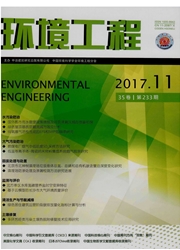

 中文摘要:
中文摘要:
为优化电催化氧化操作条件、降低能耗,考察了电解温度、直流电源电流密度、方波脉冲电源频率、占空比等工艺控制参数对苯酚模拟有机废水COD去除率的影响。同时,以水杨酸为羟基自由基(·OH)捕捉剂,通过高效液相色谱分析技术对不同电氧化操作条件下·OH的生成量进行间接检测。结果发现,苯酚溶液的COD去除率随电解温度的升高而下降,随电流密度的增大而升高;随着脉冲频率与占空比的增加,苯酚溶液COD去除率均呈现先升高后下降的规律,在脉冲频率为500Hz、占空比为50%时达到最高。操作条件对·OH生成量的影响与其对苯酚溶液COD去除率的影响规律一致,表明操作条件通过影响生成及进入到电解体系中的·OH量从而影响电氧化效率。比较发现,脉冲电源的单位COD处理能耗相比直流电源降低44%,具有明显节能效果。
 英文摘要:
英文摘要:
In order to optimize the operating conditions and lower the energy consumption for electro-oxidation, the influences of electrolyte temperature, DC current density, pulse frequency and duty ratio on COD removal rates in phenol simulated wastewater were examined. High performance liquid chromatography (HPLC) with UV detector was employed to determine the amount of hydroxyl radicals ( · OH) generated under various operation conditions by using salicylic acid as a trap. It was found that COD removal rates decreased with raising the electrolyte temperature. A rise in DC current density resulted in a higher COD removal rates. The increase of the pulsed frequency and duty ratio leaded to a rise first and then a drop of the electro- degradation efficiency, with the optimum efficiency being achieved at 500 Hz,duty ratio of 50%. The influences of various operating conditions on the generation of · OH followed the same tendency as its effect on COD removal rate in phenol solution, which indicated that the operating conditions affected the electro-oxidation efficiency through influencing the amount of .OH generating and entering the electrolysis system. The calculation result of energy consumption for per COD removal indicated that the pulse electrolysis lowered energy consumption of 44% than the non-pulse one, which was more energy efficient.
 同期刊论文项目
同期刊论文项目
 同项目期刊论文
同项目期刊论文
 期刊信息
期刊信息
